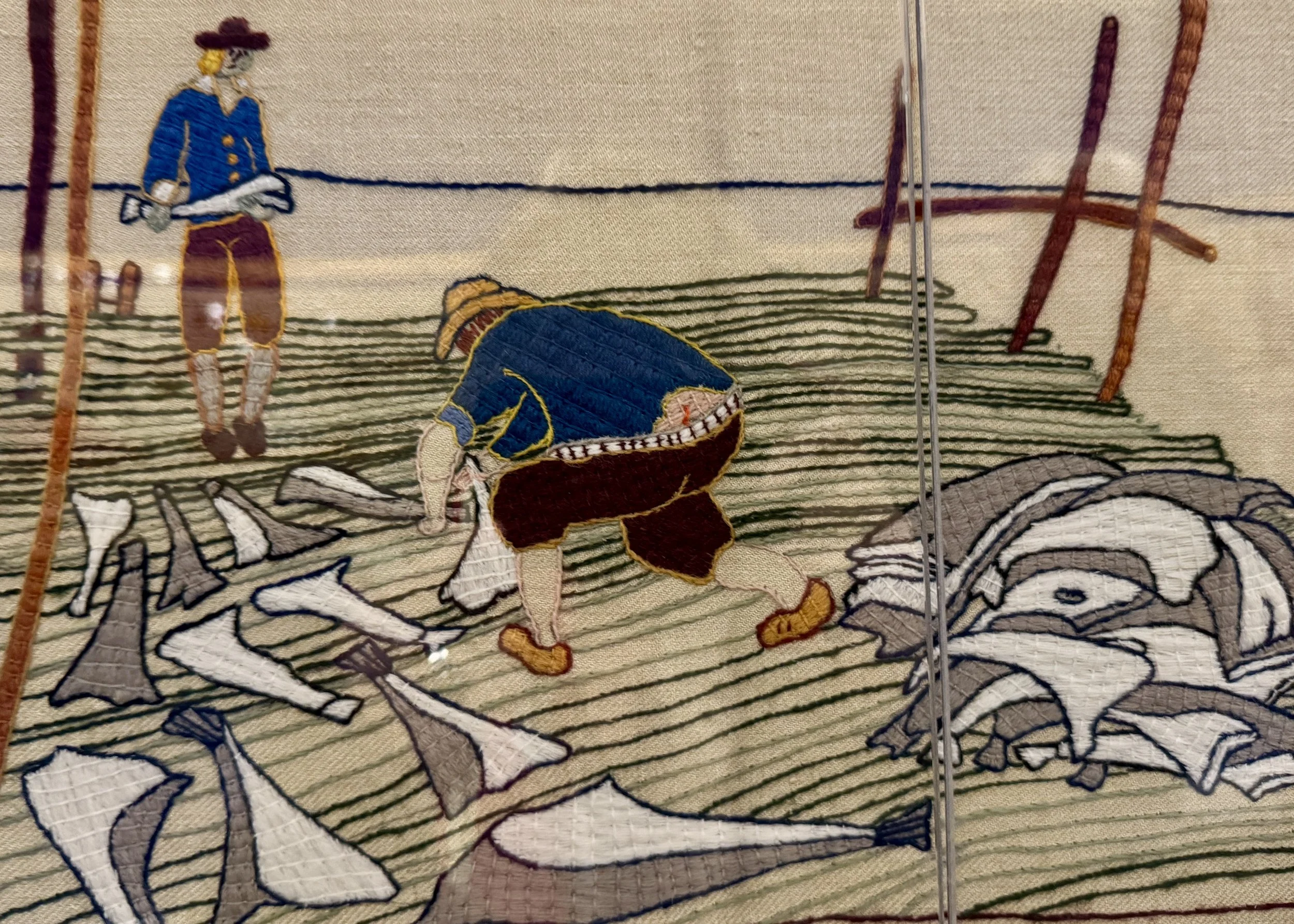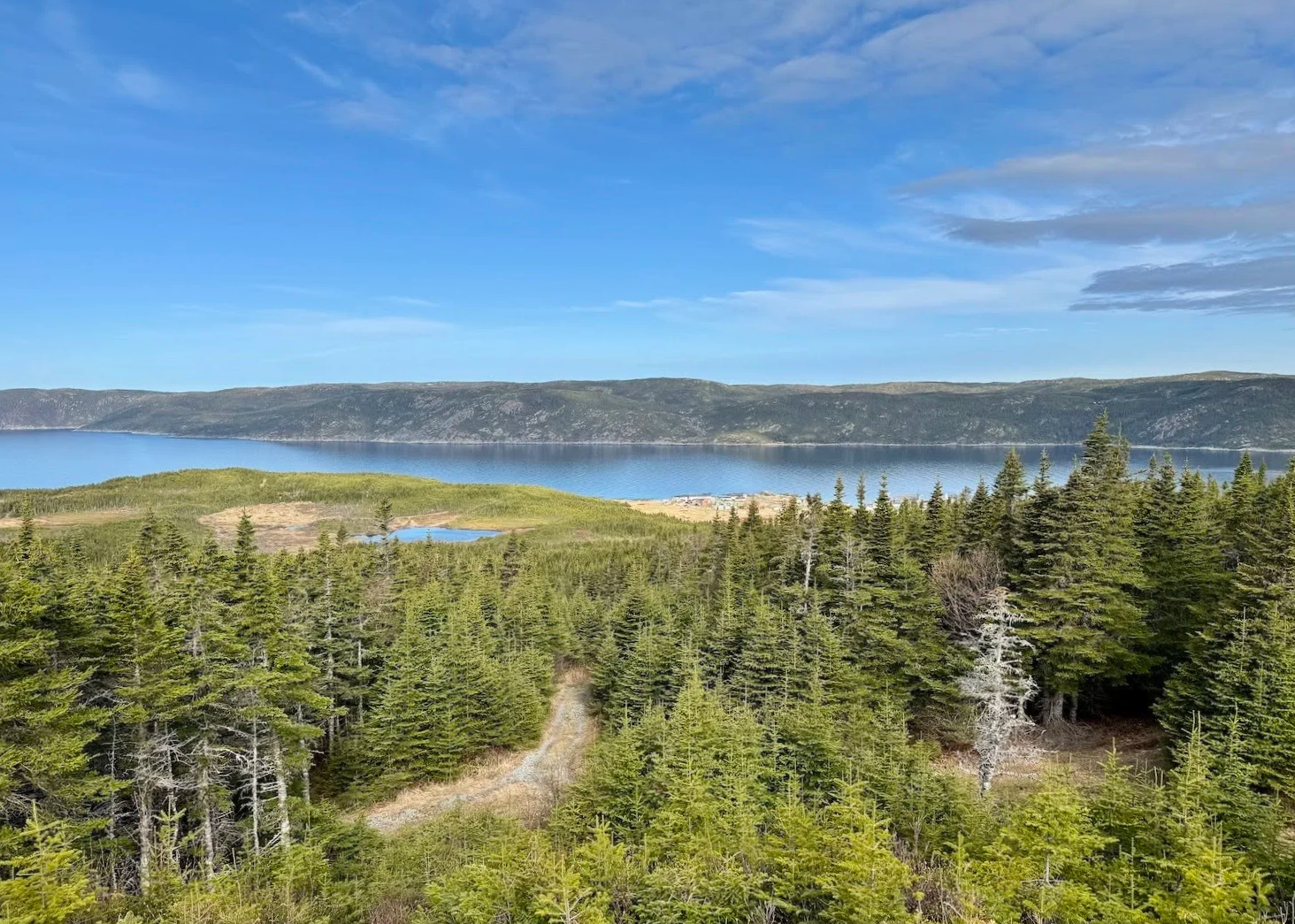How Embroidery Tells the Tale of Tiny Conche in Rural Newfoundland
Published November 5th, 2025
Photography by Jennifer Bain
Joan Simmonds teaches embroidery.
In the French Shore Interpretation Centre in the fishing community of Conche, I’m quietly mangling my embroidered salt cod. The Bayeux stitch is getting the better of me, threading wool is a challenge and I’m acutely aware of the remarkable 217-foot embroidered tapestry on display one floor above me.
But then Toni Kearney arrives with a feed of fish cakes with mustard pickles and talk turns to how salt cod is soaked, mashed with potatoes and dried savoury, and transformed into one of Newfoundland and Labrador’s favourite dishes. You must slowly pan-fry these scrumptious patties at medium-low heat, just like you need patience to master a new craft like embroidery.
“Oh my god that’s beautiful — you’ve done a wonderful job,” French Shore Historical Society director Joan Simmonds politely enthuses. “You get the idea of it. All you do now is you fill in those three little pieces. Do you want the wool to take with you? And a needle? You can send me a picture of it when you finish.”
Moratorium Tours & Retreats founder Toni Kearney in Conch.
I’ve come to Conche, way off the beaten track on the Great Northern Peninsula, to meet Kearney and see what her Moratorium Tours & Retreats experiences are all about. She hosts one guest at a time — sometimes couples — for five-night deep dives into what makes this overlooked outport so special.
The company is, of course, named for July 2, 1992, the day that the federal government banned northern cod fishing along Canada’s east coast and destroyed a treasured way of life. Newfoundland has never really recovered from the largest mass layoff in Canadian history.
Kearney hopes tourism will help revitalize Conche, which has lost about 320 of its 450 people.




She takes me on a community walk and then hiking to the Glass Hole, a spectacular cavern in the seaside cliffs. Her uncle Gerard Bromley provides a history lesson at the war-era wreck of a small plane. She makes my sea-to-table meals (including the best sandwich I’ve ever had) since there’s no restaurant, sets up an open tab at the convenience store and sends me to Foley’s House to meet sourdough baker Rachel Foley, commune with goats and learn about fireweed to fiddleheads on a herbal walk.
Recreational cod fishing hasn’t opened for the season and the northern lights aren’t out during my June visit, but there are several icebergs offshore and the real star of Conche is that 217-foot (66-metre) tapestry kept in a climate-controlled, windowless room at the interpretation centre.
Joan Simmonds tells Quebec tourists about Conche's famous tapestry.
Inspired by the Bayeux Tapestry in Normandy, the French Shore Tapestry uses Jacobean linen twill and two-ply crewel yarn to tell a regional story that was rapidly disappearing.
It starts with the Maritime Archaic people and the original wildlife, like the now extinct Great Auk. It details the arrival of Viking explorers, Basque whalers and European cod fishermen, delves into naval history, confederation, resettlement and the moratorium, and ends with the tapestry’s creation story.
Search the tapestry for secret elements of humour.
Thirteen local women, led by Simmonds, spent 20,000 hours stitching French/Canadian artists Jean Claude and Christina Roy’s design to life between 2006 and 2010.
“Only three of us knew how to embroider and we had to teach the other ladies how to do it,” confides Simmonds during a private tour and workshop arranged by Kearney. “Because the women were not satisfied with their own work, they were putting it in and taking it out. Finally, I wrote a big, long notice to them — `What you have stitched, you have stitched. Move on.’ At the end of the tapestry, you’ll see those words because they wanted to put it in.”
A view of Conche from a hiking trail spot called the Lookout.
Conche is an awkward spot, three hours northeast of Gros Morne National Park and two hours south of L’Anse aux Meadows National Historic Site, but well off the highway known as the Viking Trail. Some 2,700 people do find their way here each year, on snowmobiles or bus tours waiting out Labrador ferry delays, or in RVs because they’ve heard through the Terego network that they can park overnight in exchange for visiting.
“I should have told you you were going to get a history lesson,” Simmonds teases during an hour-long tour for me and some Quebec RVers. “Sorry. If you want to leave at any time, you can.”
Joan Simmonds stands at the French Shore Tapestry entrance.
Not a chance. Not when there are embroidered whales, gulls, polar bears and seals to ogle (but no moose because that species wasn’t introduced until 1904). There’s plenty of hidden humour, like humping caribou, a mouse in a shoe and a fisherman’s butt crack. In adjoining rooms, there’s a community museum and a gift shop that sells embroidery kits.
The interpretation centre is “seasonal but open year-round” because Simmonds welcomes anybody who calls and asks to be let in. She’d love to see more visitors — something she believes could happen if the government finally grants her wish for signage along the busy Viking Trail near Plum Point to direct people just an hour off the highway to Conche.
As for Kearney, she wants this “place where stillness fills the soul” to feel like a second home for guests as they develop deep connections with the locals. And those embroidery workshops? They’re two hours and a steal at $35, but once you get to talking with Simmonds, chances are they’ll last much longer.






